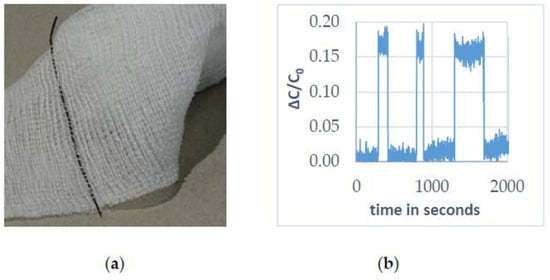Abstract
The integration of strand-based pressure sensors directly into woven textiles is a promising strategy to maintain textile properties, such as the flexibility, and to functionalize fabrics. The development of capacitive sensing elements is often based on the construction of laminates, which adversely affect the flexibility and thickness of textiles. In this paper, we present two alternative approaches by manufacturing cylindrical, pressure-sensitive, variable capacitors and twisted strand-based capacitive sensors. They lead to an easy integration method, where sensors can either be embedded or used to construct the body of textiles. In the cause of these studies, SBR/gelatin has been found to be a very useful pressure sensitive insulation system for the production of low cost capacitive sensors.
Keywords:
: pressure sensor; smart textiles; capacitive; textiles; wearables; sensor design; coaxial; twisted 1. Introduction
As the interest in wearable computers increases, there is also a growing demand for new cost- effective, functional designs and new methods for the combination of electronic components with suitable carrier systems [1]. The integration into textiles such as garments represents a smart and functional method for the construction of body-worn health monitoring and surveillance systems [2]. The integration of sensors in clothing has several advantages over the use of conventional monitoring systems. Once dressed, the embedded sensors are automatically located at the right part of the body and there is no need for end-user adjustment. Smart textiles are a very comfortable solution for the end user. Such systems can be used in many applications such as sports [3], personal health care or motion detection [4].
The high flexibility and elasticity of textiles represent the most challenging properties for the construction and integration of electronic parts and sensors. Textiles usually do not provide optimal measurement conditions, since material-related stretching and compression of individual areas may affect the results. These limitations and requirements of the measuring system make it necessary to reconsider old concepts for sensor design and to develop new ones. This work presents a new strategy in the development of capacitive pressure sensors and their inconspicuous integration into the body of textiles. Multiple approaches were investigated, using different design concepts and materials.
Previous Designs
Methods for the development and integration of sensors for measuring pressures in textiles are numerous, but most do not meet the requirements for textile systems such as garments. The decision to use a particular measuring system also depends on the required accuracy of the sensor and the complexity of production and integration. For these reasons, mainly capacitive sensors are used. These are usually mounted on textiles as layer-based systems. Meyer et al. [5] presented a layer-based system made of textile materials such as conductive yarns. Due to the low thickness of textiles, such sensor systems are not suitable for the use in clothing textiles. Lee et al. [6] presented another approach for a pressure sensor array by creating a grid of multiple electrically conductive and isolated strands made of SBS/AgNP coated Kevlar fibers insulated with PDMS. A high stiffness of the conductive fiber strands ensures a good measuring accuracy, but also limits the applicability in textile products. Another pressure sensor array made of PEDOT:PSS and CytopTM coated nylon fibers, presented by Takamatsu S. et al. [7], meets the requirements for elasticity and flexibility, but does not represent a low-cost solution. In contrast, low cost solutions are often based on resistive sensors that mostly lack in accuracy as they show cross-sensitivities to strain, temperature, humidity and other parameters.
2. Sensor Designs and Methods
The design of sensor elements is crucial for both general applicability and intended use in textiles. Textiles are often considered as two-dimensional surfaces due to their low thickness of about one millimeter. Since many sensor designs are not compatible with the given structures, sensors are often mounted on top of textiles as previously described. As a result, the flexibility and elasticity of fabrics is generally negatively affected. If the sensor elements form the body of the textile, the flexibility and elasticity can be maintained. In textiles, warp and weft threads enable the integration of strand-based sensors, each replacing one thread. The structure can also be utilized for the formation of sensor arrays.
Our development of single-strand based sensors focuses on the design process of easy-to- manufacture sensor geometries, including material development and electrical engineering. The aim of such easy-to-manufacture sensors should be that they can readily be integrated into fabrics during the manufacturing process. For this reason, only concepts are considered in which the function of sensors is independent of their insertion direction. For example, sensors based on plate capacitors show a dependence on the load direction due to the orientation of the opposing surfaces. Therefore, only concepts of twisted and coaxial single-strand based sensors can be described as suitable for this purpose, as presented in Figure 1.

Figure 1.
Schemes of suitable strand-based sensors for the use in the body of textiles (a) twisted electrode arrangement, (b) coaxial electrode arrangement.
Three different approaches were investigated. First, a twisted electrode arrangement consisting of two carbon nanotubes containing strands (T-CNT) is presented. Each electrode strand is made of a cotton thread that is dip coated in a solution containing carbon nanotubes (CNT), carbon black particles (CB) and a Binder. Subsequently the electrodes are additionally equipped with a pressure- sensitive three-layer insulation system. This system consists of a gelatin layer in the middle, which is covered/coated on both sides by a layer of styrene-butadiene rubber (SBR). The gelatin layer was prepared by immersing gelatin in water and heating at 100 °C for several minutes. Thus, the gelatin layer contains water and serves as a suitable dielectric. The permittivity and pressure sensitivity can be regulated during the preparation time of the gelatin.
Second, a coaxial sensor system based on the use of copper electrode layers (C-CuL) was made. The system consists of a copper-coated cotton thread additionally coated with a pressure sensitive layer formed by a silicone printing paste, another conductive copper layer and a protective layer. The electrodes were prepared by electroless copper deposition as described in reference [8].
Third, another coaxial sensor system based on the use of carbon nanotube electrode-layers (C-CNT) is presented. The system consists of six layers surrounding a cotton thread: a first conductive layer, a three-layer pressure-sensitive insulation system made of SBR and gelatin, another conductive CNT layer and finally a protective layer. In the case of coaxial prototypes, polydimethylsiloxane was used to form the protective layers.
The capacitance measurement is performed with a Keysight U1733C handheld LCR-meter and a Biologic VSP potentiostat. The optical examination of the sensor elements is carried out using a Keyence laser microscope from the VK-X series.
3. Results and Discussion
The measured capacitances of the sensor elements differ by the type of electrode arrangement, electrode length, measuring frequency and materials used. A measurement frequency of 100 kHz and an electrode length of 4.0 cm was used in all measurements, and the results are shown in Table 1.

Table 1.
Structure and average capacity values of different sensor element types with a length of 4 cm. The results shown refer to a measuring frequency of 100 kHz.
Both the coaxial and twisted electrode arrangements show good sensitivity to moderate pressure changes of up to 10 N/cm2. For twisted electrode arrangements, the parameter of twists per meter (TPM) predominantly determines the statistical error of the measurement. In the case of T-CNT, the electrode-strands are twisted with at least 300 turns per meter. At contact areas of at least one square centimeter, this leads to relatively small standard deviations. In addition, there is no displacement of the insulator material in case of pressure overload. Similar results can be observed for prototypes of the coaxial sensor element type C-CNT.
For the sensor elements C-CNT and T-CNT, different pressure ranges can be set by the heating time of the gelatin for the pressure sensitive layer of the system. A change in the thermal energy also leads to a change in the water content and thus the permittivity changes. Heating for three minutes at ca. 100 °C is a compromise between processing conditions, stability of the material, pressure sensitivity and reproducibility of the results. In contrast, C-CuL sensor elements were based on the use of silicone printing pastes. Thus, the material predefines the compressibility and the coverable measuring range. When using the silicone printing pastes, a plastic deformation of the insulator is observed under pressure overload. Due to the plastic deformation of the insulator, the copper layers are deformed, which reduces the measurable capacity. To avoid errors, it will be necessary to load the respective sensor element with the maximum expected force during calibration. If the force applied during calibration is not exceeded in subsequent measurements, only minor deviations will occur. If the load is significantly exceeded, a fresh calibration of the C-CuL sensor elements will be required. The described prototypes exhibit satisfactory pressure sensing functionality and have the proper dimensions and flexibility to be integrated in textile bodies. An example of integration into bandages is shown in Figure 2.

Figure 2.
Capacitive sensor elements made by the use of CNT and gelatin/SBR-Insulation show (a) a suitable size for the integration into textiles and (b) a good signal change under pressure load.
4. Conclusion
Based on these approaches it can be shown that twisted and coaxial sensor elements are suitable for the integration in textiles and for the use as capacitive pressure sensors. Furthermore, the combination of gelatin with SBR as insulation layer allows the construction of high permittivity flexible insulators. In this context, electroless copper deposition may be used as a low cost method of producing electrode layers. However, the brittleness of the electrode material poses a problem in highly flexible and elastic systems, and therefore materials such as CNT or conductive polymers may be used instead to form flexible layers.
Acknowledgments
This research was financially supported by the Austrian research promotion agency (FFG) K Project tccv (FFG-860474) and by the Vorarlberg government. Authors gratefully acknowledge financial support from the Austrian Federal Ministry of Transport, Innovation and Technology (BMVIT) to the Endowed Professorship Advanced Manufacturing (FFG-846932).
Conflicts of Interest
The authors declare no conflict of interest. The founding sponsors had no role in the design of the study; in the collection, analyses, or interpretation of data; in the writing of the manuscript, and in the decision to publish the results.
References
- Lumelsky, V.J.; Shur, M.S. Sensitive Skin. IEEE Sens. J. 2001, 1, 44–51. [Google Scholar] [CrossRef]
- Binkley, P.F. Predicting the potential of wearable technologies. IEEE Eng. Med. Biol. Mag. 2003, 22, 23–27. [Google Scholar] [CrossRef] [PubMed]
- Zeng, W.; Shu, L. Fiber-Based Wearable Electronics: A Review of Materials, Fabrication, Devices, and Applications. Adv. Mater. 2014, 26, 5310–5336. [Google Scholar] [CrossRef] [PubMed]
- Cai, L.; Song, L. Super-stretchable, Transparent Carbon Nanotube-Based Capacitive Strain Sensors for Human Motion Detection. Nat. Sci. Rep. 2013, 3, 1–8. [Google Scholar] [CrossRef] [PubMed]
- Meyer, J.; Amrich, B. Design and Modeling of a Textile Pressure Sensor for Sitting Posture Classification. IEEE Sens. J. 2010, 10, 1397–1398. [Google Scholar] [CrossRef]
- Lee, J.; Kwon, H. Conductive Fiber-Based Ultrasensitive Textile Pressure Sensor for Wearable Electronics. Adv. Mater. 2015, 27, 2433–2439. [Google Scholar] [CrossRef] [PubMed]
- Takamatsu, S.; Kobayashi, T. Fabric pressure sensor array fabricated with die-coating and weaving techniques. Sens. Actuators A Phys. 2012, 184, 57–63. [Google Scholar] [CrossRef]
- Root, W.; Aguiló-Aguayo, N. Conductive layers through electroless deposition of copper on woven cellulose lyocell fabrics. Surf. Coat. Technol. 2018, 348, 13–21. [Google Scholar] [CrossRef]
Publisher’s Note: MDPI stays neutral with regard to jurisdictional claims in published maps and institutional affiliations. |
© 2018 by the authors. Licensee MDPI, Basel, Switzerland. This article is an open access article distributed under the terms and conditions of the Creative Commons Attribution (CC BY) license (https://creativecommons.org/licenses/by/4.0/).